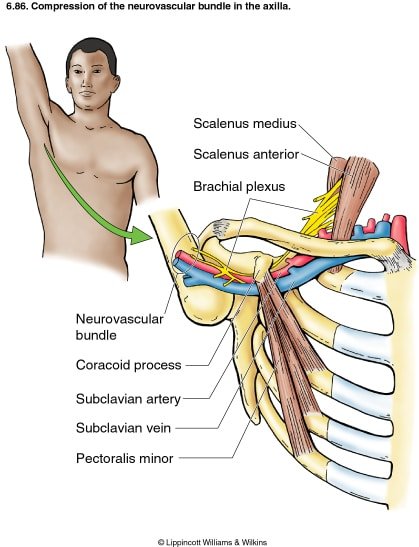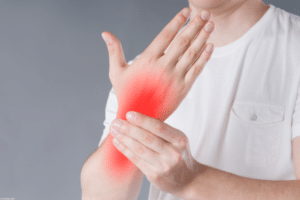Introduction
Discover the keys to understanding and managing Thoracic Outlet Syndrome (TOS), a condition impacting around 8% of the population. Dive into this essential guide, enriched with insights from Physio Pros Oakville, a renowned clinic at the forefront of musculoskeletal health.
TOS Causes: Decoding Neurovascular Compression Explore the intricate web of causes contributing to TOS, where neurovascular structures in the thoracic outlet face compression
Here are the primary triggers:

Anatomical Variations:
One of the most noticeable variations is the presence of a congenital cervical rib, an additional rib found in around 0.5% of the population. Both complete and partial cervical ribs are typically identifiable through standard X-rays of the chest or neck.
(Reference: Wahington University School of Medicine in St.Louis)
Poor Posture and Muscular Imbalances:
Poor posture and muscular imbalances can significantly contribute to the development of Thoracic Outlet Syndrome (TOS). When individuals consistently maintain improper posture, especially in activities involving repetitive overhead movements or prolonged periods of slouching, it can lead to muscular imbalances in the neck and shoulder region.
The undue stress on muscles and soft tissues can result in tightness, inflammation, and dysfunction. Over time, these muscular imbalances may compress the neurovascular structures in the thoracic outlet, exacerbating TOS symptoms.
Addressing poor posture through corrective exercises, ergonomic adjustments, and targeted physiotherapy plays a crucial role in managing and preventing the progression of Thoracic Outlet Syndrome.
Trauma and Injuries:
Trauma and injuries represent another significant factor in the onset of Thoracic Outlet Syndrome (TOS). Accidents or injuries that impact the neck or shoulder region can lead to inflammation, scarring, and structural changes in the affected area.
This can result in the compression of nerves, arteries, and veins passing through the thoracic outlet, contributing to the development of TOS symptoms. Whether it’s a sudden impact or repetitive trauma, the consequences can disrupt the delicate balance of the neurovascular structures, emphasizing the importance of timely intervention and rehabilitation to mitigate the effects of trauma-induced TOS.

TOS Case Study at Physio Pros Oakville
Embarking on a transformative journey with Physio Pros Oakville, Victoria, a 35-year-old professional, sought relief for persistent symptoms of Thoracic Outlet Syndrome (TOS), including neck and shoulder pain accompanied by tingling sensations.
Under the expert care of registered physiotherapists and massage therapists, a tailored treatment plan was devised, incorporating posture correction exercises and therapeutic massage to address the neurovascular compression in the thoracic outlet.
Through consistent sessions, Victoria experienced remarkable improvement, with a notable reduction in TOS symptoms. The collaborative and personalized approach at Physio Pros Oakville not only alleviated her immediate concerns but also empowered Victoria with tools for ongoing self-management, highlighting the clinic’s commitment to comprehensive TOS care.
Frequently Asked Questions
Common symptoms of TOS include neck and shoulder pain, arm numbness, tingling sensations, and weakness. Individuals may also experience swelling or discoloration in the hands.
Yes, prolonged poor posture, especially involving repetitive overhead movements, can contribute to muscular imbalances and increase the risk of developing Thoracic Outlet Syndrome.
Yes, targeted exercises to improve posture and strengthen muscles in the neck and shoulder region can help alleviate TOS symptoms. Consultation with a physiotherapist is recommended for personalized exercise plans.
Surgery may be considered for severe cases of TOS or when conservative treatments are ineffective. It aims to relieve compression on the affected nerves or blood vessels in the thoracic outlet.
TOS is not extremely rare, affecting around 8% of the population. Anatomical variations, trauma, and poor posture contribute to its occurrence, making awareness and early intervention crucial for effective management.







